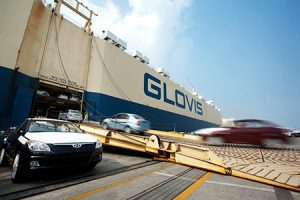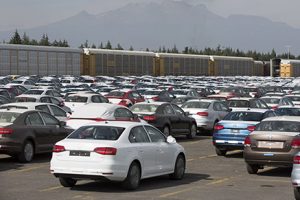 Carmakers and logistics providers are now starting to bring ‘Uber-like’ tracking and delivery forecasts to the finished vehicle sector...
Carmakers and logistics providers are now starting to bring ‘Uber-like’ tracking and delivery forecasts to the finished vehicle sector...
In this story...
Mabry, a senior manager in the carmaker’s finished vehicle logistics department, recalls some of the dealer feedback the company had been receiving in recent years as the technology market began to explode with an array of delivery tracking platforms related to online shopping and other services.
“We’ve seen the world change and our expectations have grown,” says Mabry, pointing to consumer experiences that are now dominated by quick turnarounds via online purchases. “When Domino’s first came out with a pizza tracker, dealers said to us: ‘I can track a $9 pizza – why can’t you give me better data on a $40,000 vehicle?’ They see that Amazon is tracking, FedEx is tracking, UPS is tracking and now absolutely everyone is tracking.”
The desire to satisfy such demands for enhanced visibility of tracking information among dealers, as well as individual consumers purchasing custom-order vehicles, has inspired systems that can analyse and deliver details related to ETAs on a granular level. From OEMs and transport providers improving (or replacing) legacy systems, to specialists emerging within a growing market that features tracking technology in the form of mobile applications, the amount of information available on the ETA of any given vehicle shipment has never been greater.

“In terms of where could this go, it’s pretty endless in some ways. What’s driving this is instant gratification or a need to understand. The mobile app delivers information at our fingertips,” observes Wayne Pollock, co-founder of Car Delivery Network, whose company has grown in just six years to track the final truck transit to dealerships of nearly 3m vehicles per year. “We thought we could add value by starting at the last part of the supply chain and the carriers are finding value in the information we’ve been able to provide for them. If you will, it’s an ‘Uberisation’ of this marketplace.”
While advancements in technologies have made it much easier to access an abundance of information about movements through the supply chain, the processes behind mining the relevant data at an OEM level, and presenting the content with the most value to the end user in a quickly digestible format, can prove quite complex. Logistics professionals involved in bringing vehicles to the market are faced with the challenge of evaluating and implementing the most effective tracking platform suited to the demands of their supply chain.
For many, the focus on using the latest data systems and equipment is something new. As such, it still has quite a long way to develop, especially as carmakers look to improve their ETAs and move from providing a delivery window of, say, a week or several days to one within a day, or even a specific time. For now, many companies are still transitioning from manual, paper-based processes.
“From my point of view, technology was not the main focus on this part of the supply chain. The manufacturer concentrated on the inbound part of the supply chain with parts and not as much on the outbound,” says Frank Schnelle, general manager of Glovis Europe, which oversees the supply chain for Hyundai and Kia throughout the continent.
[sta_anchor id="1"]“We saw a change about 10 or 15 years ago in the European market,” he explains. “There’s more focus on the production stages of the vehicle and the information that is available. It has become more important to keep the promised delivery date to the customer. There seems to be a greater desire now for this information – even down to the last mile, in fact.”
An enhanced ETA platformThe enhancements to Volkswagen’s dealer-facing portal involve a process that monitors more than 5,000 route-legs with integrations across various stages including factory, vessel and port tracking system improvements for Volkswagen and Audi brands. Algorithms fed into the portal now include data from more than 3,000 locations and 37 checkpoints.
 "We know that if we have stable processes and meet our metrics, then it becomes a seamless experience for our dealers, who are our direct customers. They, in turn, can then help their end customers.... We want to do our job so well that we are invisible to the world." - Scott Mabry, VW of America
"We know that if we have stable processes and meet our metrics, then it becomes a seamless experience for our dealers, who are our direct customers. They, in turn, can then help their end customers.... We want to do our job so well that we are invisible to the world." - Scott Mabry, VW of America
“At VW, we looked at it, and each piece of the system has its own visibility. The question became: ‘how do we get the data together and how do we present it to the dealers?’,” says Mabry. “But it’s a lot of data. Take the example of last-mile tracking. Do we want to send an update to the dealer every two minutes? No, we know they don’t want the flood of data.
“Our new ETA engine is calculating historical averages to the hours of delivery. From [showing] it will be there next week [prior to the recent enhancements], we can now say it will be there during the first half of next week.”
Mabry adds that Volkswagen has also been improving accuracy down to the delivery day, with notable improvements; he predicts that the carmaker will eventually be able to narrow delivery down to the last mile and tell dealers a truck will arrive in half an hour.
“We’re not there yet,” says Mabry. “But we are down to very tight timeframes; information like ‘the truck left the rail ramp yesterday and typically it’s there 30 hours later’. We’re still giving our dealers rough windows, rather than precise times.”
Prior to implementation of the new ETA application, VW Group of America’s overall accuracy with projected ETAs stood in the region of 40%. Since launching the enhanced application, that has risen to more than 85% of deliveries.
“Each part of the supply chain informs a central system of its activities for a vehicle in a real-time environment,” says Mabry. “The ETA logic engine uses these inputs as well as routing tables and historical data to provide the current ETA. The ETA engine runs as events arrive to it and sends new results to the dealer websites.”
This level of accuracy compares favourably with others in the market. Carmakers such as American Honda and Subaru also have ETA systems that offer similar accuracy, which is adjusted as vehicles move through the supply chain. But other carmakers, such as General Motors in North America, don’t currently offer dealers ETAs – though it is likely this will change.
One of the key decisions made in the development of Volkswagen’s enhanced ETA platform dealt with the presentation of the deeper dives into the available data. Instead of providing the dealers with a new tracking portal filled with updated options that could require training time for the end users, the VW Group chose to incorporate the ETA information dealers had requested through the company’s current and familiar portal.
“With our dealer-facing portals, there’s always been an ETA presented to them – giving a timeframe of delivery. What we have changed is the logic engine in the background and the data feeds that we are [sta_anchor id="2"]getting from the outside suppliers,” explains Mabry. “These changes make what we are showing them more accurate. They don’t see all the changes that we have made, but they will get the results of it.
“There are different uses for the ETA engine and I know that the consumer-facing part of our brands wants to give the consumers the best experience.”
Managing expectationsAccording to those responsible for overseeing the management of tracking systems, the greatest value found within detailed ETA information is the visibility of exceptional situations. Given that most automotive supply chains run with efficiency percentages in the high nineties, the ability to rapidly identify issues and take proactive measures has become invaluable for those involved in bringing vehicles to the consumer market.
“The real exercise comes when you have to address the unplanned situation,” says Schnelle, noting that Glovis spent six years developing its current system for Hyundai and Kia. “You want to have this information visible as soon as possible. You want the right information visible to take the proper actions to address the situation.”
While ETAs are highly impacted by specific operational events or disruptions – such as available capacity or weather – some experts suggest their accuracy is just as tied to network planning and design.
“ETA is mostly perceived as a task for the operational guys, but we really believe it starts with having the right network, getting the right capacity in place and making sure that the contractual environment with your supplier base is set up in an optimised way,” explains Hartmut Haubrich, director of finished vehicle logistics systems at German IT firm Inform, where he leads a team of 30 people dedicated to developing and managing software solutions that offer optimal tracking.
“If the network is designed in the right way, it’s not only more cost-efficient, but it’s also more stable. The critical things with ETAs are the things that don’t happen. We can create events and alerts on what did not happen. We want to manage the exceptions in order to still make the ETA that you promised on day one.”
Meanwhile, Brian Hook, vice-president of operations at software provider ICL Systems, also has his team focused on flagging exceptional situations through understanding each link of the supply chain.
[sta_anchor id="3"]“Calculating an accurate ETA goes far beyond simply knowing the current location of a vehicle. If the next hand-off point has a high degree of variability, that will impact the ETA,” says Hook. “If there is a downstream route change due to congestion or diversion, that also will impact the ETA. Another factor that must be considered is dealer operating hours and holidays.”
 JLR’s tracking system pulls GPS data from sim cards in its vehicles and captures signals that are sent each time they are started or switched off en route
JLR’s tracking system pulls GPS data from sim cards in its vehicles and captures signals that are sent each time they are started or switched off en routeStaying invisible to the worldThe coming wave of technology promises to provide even closer vehicle tracking – from vehicles leaving the assembly line to those reaching their final destination at the dealership. According to Haubrich, Jaguar Land Rover has begun using a system that pulls GPS tracking information from SIM cards within the vehicle. A tracking signal is generated each time the vehicle’s ignition is engaged and switched off. BMW is also running trials with such technology, while OEMs in the US are also starting to explore it further.
“We know that meeting customer timing can be the difference [when] securing a sale, and these new technologies are enabling us to see into the network faster and more efficiently,” says Luca Kolcaj, manager of finished vehicle operations for Fiat Chrysler Automobiles US. “As technological advances are made, vehicles are now being equipped with standard features that would allow FCA US to geo-map current vehicle locations. Having real-time information gives us the ability to get the most up-to-date transport performance without having to rely on vendors or carriers to report.”
However, with both the current advancements and those on the horizon, Hook cautions that OEMs and other participants in the supply chain must become more vigilant in terms of the way new technology is integrated with legacy systems.
“The underlying data exchange process, which is still largely dominated by traditional EDI [electronic data interchange], is one area that is overdue for improvement,” says Hook. “Some OEMs do communicate with us via web services, which is essential if you want true, real-time updates. Change comes slowly to this industry, but over the next ten years, I would expect to see web-based APIs [application programming interface] largely replace the use of EDI.”
Michael Bünning, managing director for BLG Automobile Logistics, based in Germany, also believes that ETAs will become increasingly important as new technology develops, and consumer patterns change in terms of how they purchase and use vehicles.
“We will not only be delivering cars to dealers, but to the final consumer as well. They [the final consumer] will not stay the whole day at home waiting for the car,” he predicts. “They will need a much more accurate ETA to be there, knowing when the car will finally arrive.
“Whether this will create more efficiency or more throughput [in the supply chain], I have my doubts,” he adds.
Though many of the tools have been updated and may yet be totally revolutionised by technology, VW Group’s Mabry notes that the mission remains the essentially same: tracking shipments and projecting possible storage as well as finishing processes based on an expected time of delivery.
“When I first started, we were still handling manual, paper freight bills,” he recalls. “We know that if we have stable processes and meet our metrics, then it becomes a seamless experience for our dealers, who are our direct customers. They, in turn, can then help their end customers.
[sta_anchor id="4"]“Working in logistics, we need to make our part of that job seamless to the dealer and to the customer,” he concludes. “Logistics’ goal is flawless execution. We’re in that part of the world where, if it’s on time, you don’t notice – the same as if the mail shows up and if the lights turn on. We want to do our job so well that we are invisible to the world.”
 "We will not only be delivering cars to dealers, but to the final consumer as well. They will not stay the whole day at home waiting for the car. They will need a much more accurate ETA. Whether this will create more efficiency or more throughput [in the supply chain], I have my doubts." - Michael Bünning, BLG Automobile Logistics
"We will not only be delivering cars to dealers, but to the final consumer as well. They will not stay the whole day at home waiting for the car. They will need a much more accurate ETA. Whether this will create more efficiency or more throughput [in the supply chain], I have my doubts." - Michael Bünning, BLG Automobile Logistics
 VW hopes its new ETA app will help create satisfied end customers during the repair and buy-back of cars involved in the recent emissions court case
VW hopes its new ETA app will help create satisfied end customers during the repair and buy-back of cars involved in the recent emissions court caseIn the coming year, the enhanced Volkswagen ETA platform will have a critical role to play beyond the normal outbound vehicle supply chain: it will also be used as part of a customer service role as the company works through the massive court settlement with US federal regulators and the owners of 475,000 2.0-litre diesel-engine vehicles.
The cars in question had been manufactured to conceal emissions levels that were in excess of Environmental Protection Agency standards. As part of the 2.0-litre engine settlement, VW has made provisions amounting to around $10 billion on vehicle buy-backs and in owner compensation or potential engine repairs, if approved by the authorities.
According to a Reuters report in late October, some 340,000 car owners have agreed to participate in the settlement, while approximately 3,500 others have decided to opt out. This may well place significant pressure on the Volkswagen supply chain in the near term. The settlement calls for VW to repair or buy back 85% of the total number of cars involved within two years – or face additional penalties.
“We will be delivering more cars next year, and these [enhanced ETA] systems will help us in meeting customer satisfaction,” says Scott Mabry. “Our goal is to line up behind our dealer body and give them the best tools. So, when they tell a customer that they will have the car for them on this day, the customer will have no doubt that everyone in the company – from production all the way to our team in vehicle logistics – is standing behind them to make that happen.
“That’s regardless if it’s a used car or a new car being delivered to them, or returning a car into our auction network. In all of those transactions, the ETA plays a critical role.”





































